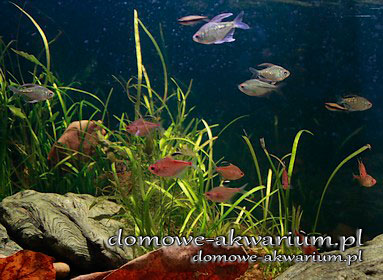
| Species | Flameback Bleeding Heart Tetra |
|---|---|
| Other names | Redback Bleeding Heart Tetra |
| Latin Name | Hyphessobrycon Pyrrhonotus |
| Family | pike-perches |
| Origin | Ameryka Południowa |
| Length | 5 cm |
| Temperature | 23 - 28°C |
| Water Hardness | soft - medium hard |
| pH | 5.5 - 7.0 |
| Aquarium Size | 60 L |
| Food | any: dry, frozen, live |
Flameback Bleeding Heart Tetra, Redback Bleeding Heart Tetra, Pyrrhonotus Bleeding Heart Tetra, Red Flame Tetra
This freshwater species is endemic to the Rio Negro river and its tributaries in Brazil. Its habitats are riverbanks with submerged roots and branches and vegetation hanging from the banks. These waters are rich in tannins and organic acids.
This species is characterized by a high body cut and laterally flattened. The body color is red-pink, with a lighter belly. There is a red spot on the body (at the height of the lateral line, behind the gill covers). The fins are milky-transparent, except for the dorsal fin. Its first rays are initially red, later black with a white-pink margin. The male is much larger and more colorful than the female. Additionally, his pelvic, dorsal, and anal fins are elongated. The female is thicker in the belly sections compared to the male.
This is a peaceful, sociable, active, and schooling species. Males can be territorial and establish a hierarchy among themselves, but they do not harm their companions. On a minimum, we should keep a group of these fish - at least 8 individuals. Then the fish feel safer, and the males color up more. For tank mates, we choose species of similar size and temperament: other tetras, Bystrzyki, Razbory, Corydoras, small armored catfish, and dwarf cichlids. We avoid slow-moving fish or those with veil fins (e.g., guppies, fighting fish, etc.).
This fish will feel good in both a community aquarium and an Amazon biotope. In the first case, the tank should be heavily planted, with free spaces for free swimming, dark substrate, and diffused light. In the second case, the substrate should be sand. On the bottom, we arrange twisted branches, roots, and dried beech or oak leaves (we replace them with new ones every few weeks). The water should have a tea color - this effect can be obtained by placing peat in the filter or in a net which we hang in the aquarium. Plants in this configuration are not necessary. These fish are sensitive to water quality - it is necessary to systematically change part of the water.

This species is oviparous. There is no information about successful breeding in the aquarium. It is only known that the female lays eggs in the water column, which fall to the bottom or stick to plants, and the parents do not care for the eggs or fry.